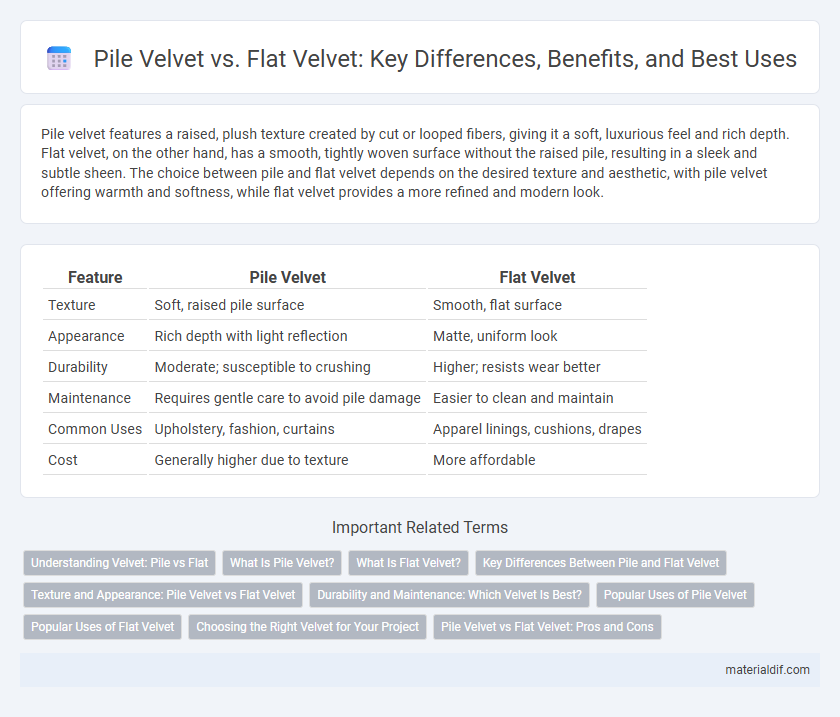Pile velvet features a raised, plush texture created by cut or looped fibers, giving it a soft, luxurious feel and rich depth. Flat velvet, on the other hand, has a smooth, tightly woven surface without the raised pile, resulting in a sleek and subtle sheen. The choice between pile and flat velvet depends on the desired texture and aesthetic, with pile velvet offering warmth and softness, while flat velvet provides a more refined and modern look.
Table of Comparison
| Feature | Pile Velvet | Flat Velvet |
|---|---|---|
| Texture | Soft, raised pile surface | Smooth, flat surface |
| Appearance | Rich depth with light reflection | Matte, uniform look |
| Durability | Moderate; susceptible to crushing | Higher; resists wear better |
| Maintenance | Requires gentle care to avoid pile damage | Easier to clean and maintain |
| Common Uses | Upholstery, fashion, curtains | Apparel linings, cushions, drapes |
| Cost | Generally higher due to texture | More affordable |
Understanding Velvet: Pile vs Flat
Pile velvet features raised fibers that create a plush, textured surface with a soft, luxurious feel, making it ideal for upholstery and garments that benefit from a rich tactile experience. Flat velvet, on the other hand, has a smooth, sleek surface with closely woven fibers, offering a refined appearance often used in drapery and formal wear. Recognizing the differences in fiber arrangement and texture helps in selecting the appropriate velvet type for specific aesthetic and functional applications.
What Is Pile Velvet?
Pile velvet is a type of velvet characterized by its raised surface made from cut or uncut loops of yarn, creating a textured, plush feel that adds depth and softness to the fabric. Unlike flat velvet, which has a smooth, even surface without raised fibers, pile velvet offers a richer tactile experience and enhanced visual richness. This fabric is often used in upholstery, fashion, and drapery due to its durability and luxurious appearance.
What Is Flat Velvet?
Flat velvet is a type of velvet fabric characterized by a smooth, even surface without the raised pile typical of traditional velvet. Unlike pile velvet, which features densely packed fibers standing upright to create a plush texture, flat velvet is woven with fibers that lay flat, resulting in a more subtle sheen and a sleek appearance. This fabric is often used in upholstery and apparel where a refined, understated look is desired, offering durability while maintaining the luxurious feel associated with velvet.
Key Differences Between Pile and Flat Velvet
Pile velvet features raised loops or cut fibers that create a soft, textured surface, offering depth and a plush feel. Flat velvet, also known as plain velvet, has a smooth, even finish with shorter fibers, resulting in a sleek and uniform appearance. Key differences include pile velvet's tactile richness and light reflection versus flat velvet's subtle sheen and durability.
Texture and Appearance: Pile Velvet vs Flat Velvet
Pile velvet features a raised, soft surface created by cut or uncut loops of yarn, giving it a plush, three-dimensional texture that reflects light variably for a rich, luxurious appearance. Flat velvet lacks this raised pile, resulting in a smoother, more uniform texture with a subtle sheen that appears more matte and less dimensional. The choice between pile and flat velvet significantly influences the tactile feel and visual depth of the fabric, with pile velvet offering a sumptuous, tactile richness and flat velvet providing a sleek, modern look.
Durability and Maintenance: Which Velvet Is Best?
Pile velvet, characterized by its raised fibers, offers superior durability due to its dense and resilient texture, making it ideal for high-traffic areas and heavy use. Flat velvet, with its smooth, even surface, requires more delicate care as it is prone to wear and visible markings, demanding gentle maintenance to preserve its appearance. Choosing pile velvet ensures longevity and easier upkeep, while flat velvet suits low-traffic settings where aesthetic delicacy is prioritized.
Popular Uses of Pile Velvet
Pile velvet, characterized by its plush, raised fibers, is widely favored in upholstery, fashion, and luxury home decor owing to its soft texture and rich appearance. Popular uses include creating opulent cushions, drapes, and evening wear where tactile depth and warmth are essential. Unlike flat velvet, which suits minimalist and lighter fabric applications, pile velvet enhances visual richness and comfort in high-end, tactile-focused designs.
Popular Uses of Flat Velvet
Flat velvet is widely popular in upholstery and home decor due to its smooth texture and durability, making it ideal for sofas, cushions, and curtains that require a sleek, refined appearance. Unlike pile velvet, which has a raised surface and a plush feel, flat velvet offers a more modern look with less maintenance, appealing to contemporary interior designs. Its ability to retain vibrant colors and resist crushing makes flat velvet a preferred choice for everyday use and high-traffic areas.
Choosing the Right Velvet for Your Project
Pile velvet features raised, textured fibers that add depth and a luxurious feel, ideal for upholstery and drapery projects requiring softness and elegance. Flat velvet offers a smooth surface with a sleek appearance, making it suitable for garments and decorative elements needing a refined finish. Selecting the right velvet depends on the desired aesthetic, durability, and project usage, with pile velvet excelling in tactile richness and flat velvet providing a modern, streamlined look.
Pile Velvet vs Flat Velvet: Pros and Cons
Pile velvet features a raised, tufted texture created by cut or uncut loops of fabric fibers, offering a plush, luxurious feel and greater warmth, but it can attract dust and show wear more easily. Flat velvet, also known as plain velvet, has a smooth, even surface that provides a sleek appearance and easier maintenance but lacks the depth and softness of pile velvet. Choosing between pile and flat velvet depends on the desired combination of texture, durability, and ease of care for upholstery or fashion applications.
Pile velvet vs flat velvet Infographic

 materialdif.com
materialdif.com